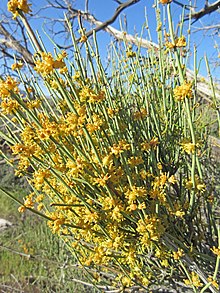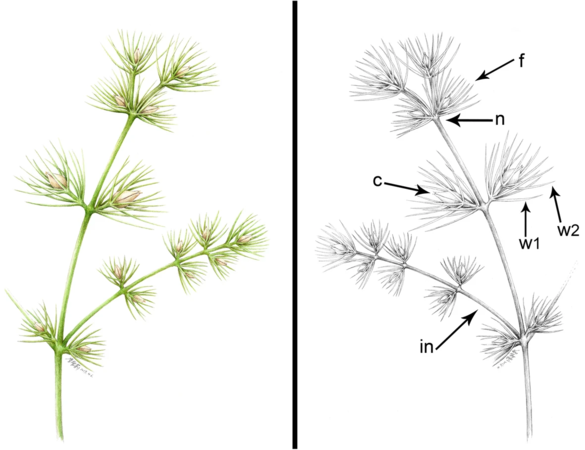Ephedraceae
| Ephedraceae Temporal range:
| |
|---|---|

| |
| Ephedra nevadensis | |

| |
| Restoration of Arlenea from the Early Cretaceous of Brazil | |
| Scientific classification | |
| Kingdom: | Plantae |
| Clade: | Tracheophytes |
| Clade: | Gymnospermae |
| Division: | Gnetophyta |
| Class: | Gnetopsida |
| Order: | Ephedrales Dumort.[2] |
| Family: | Ephedraceae Dumort.[1] |
| Type genus | |
| Ephedra | |
| Other genera | |
|
See text | |
Ephedraceae is a family of gymnosperms belonging to Gnetophyta, it contains only a single extant genus, Ephedra, as well as a number of extinct genera from the Early Cretaceous.
Taxonomy
- Fossil Ephedraceae
-
Eamesia, showing male cone (B)
-
Chengia, showing female reproductive spike (B)
-
Jianchangia, showing chlamydosperms (C) and ovulate cone (F)
-
Diagram of Arlenea, showing closeup of terminal region with female reproductive structures (B) and cross section of a female reproductive structure.(C)
Ephedraceae is agreed to be the most basal group amongst extant gnetophytes. Members of the family typically grow as shrubs and have small, linear leaves that possess parallel veins. The fossil Ephedraceae genera show a range of morphologies transitional between the ancestral lax male and female reproductive structures and the highly compact reproductive structures typical of modern Ephedra.[3][4] Modern members of Ephedra have either dry winged membranous bracts (modified leaves which surround the seed), which are dispersed by wind, leathery covered seeds, which are dispersed by seed-eating rodents, or fleshy bracts which are consumed and then dispersed by birds. Some extinct members of Ephedra from the Early Cretaceous, such as Ephedra carnosa, as well as Arlenea from the Early Cretaceous of Brazil have fleshy bracts surrounding the seeds, suggesting that these seeds were dispersed by animals.[5]
Genera
- Ephedra L. Early Cretaceous-Recent
- Arlenea Ribeiro, Yang, Saraiva, Bantim, Calixto Junior et Lima, 2023[5] Crato Formation, Brazil, Early Cretaceous (Aptian)
- Leongathia V.A. Krassilov, D.L. Dilcher & J.G. Douglas 1998[6] Koonwarra fossil bed, Australia, Early Cretaceous (Aptian)
- Jianchangia Yang, Wang and Ferguson, 2020[7] Jiufotang Formation, China, Early Cretaceous (Aptian)
- Eamesia Yang, Lin and Ferguson, 2018[3] Yixian Formation, China, Early Cretaceous (Aptian)
- Prognetella Krassilov et Bugdaeva, 1999 Yixian Formation, China, Early Cretaceous (Aptian) (initially interpreted as an angiosperm)[8]
- Chengia Yang, Lin & Wang, 2013,[9] Yixian Formation, China, Early Cretaceous (Aptian)
- Chaoyangia Duan, 1998[10] Yixian Formation, China, Early Cretaceous (Aptian)
- Eragrosites Cao & Wu, 1998 Yixian Formation, China, Early Cretaceous (Aptian)
- Gurvanella Krassilov, 1982 China, Mongolia, Early Cretaceous
- Alloephedra Tao and Yang, 2003 China, Early Cretaceous (considered a synonym of Ephedra by some authors)
- Amphiephedra Miki, 1964 China, Early Cretaceous
- Beipiaoa Dilcher & al, 2001 China, Early Cretaceous
- Ephedrispermum Rydin, K.R.Pedersen, P.R.Crane et E.M.Friis, 2006 Portugal, Early Cretaceous (Aptian-Albian)
- Ephedrites Guo and Wu, 2000 China, Early Cretaceous
- Erenia Krassilov, 1982 China, Mongolia, Early Cretaceous
- Liaoxia[11] Cao et al. 1998 China, Early Cretaceous
- Dichoephedra Ren et al. 2020[12] China, Early Cretaceous
- Laiyangia P.H. Jin, 2024[13] China, Early Cretaceous
- ?Pseudoephedra Liu and Wang, 2015[14] China, Early Cretaceous




